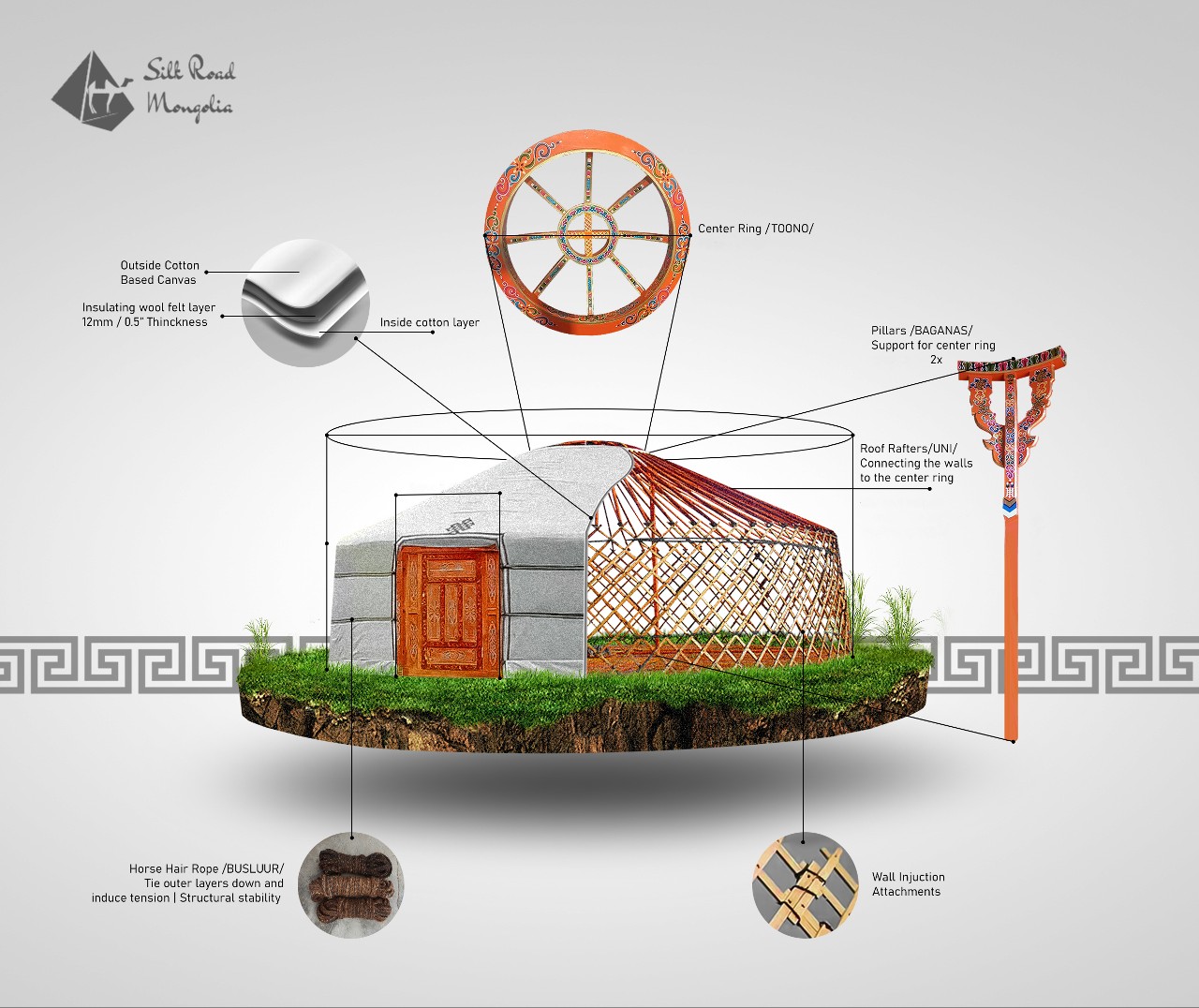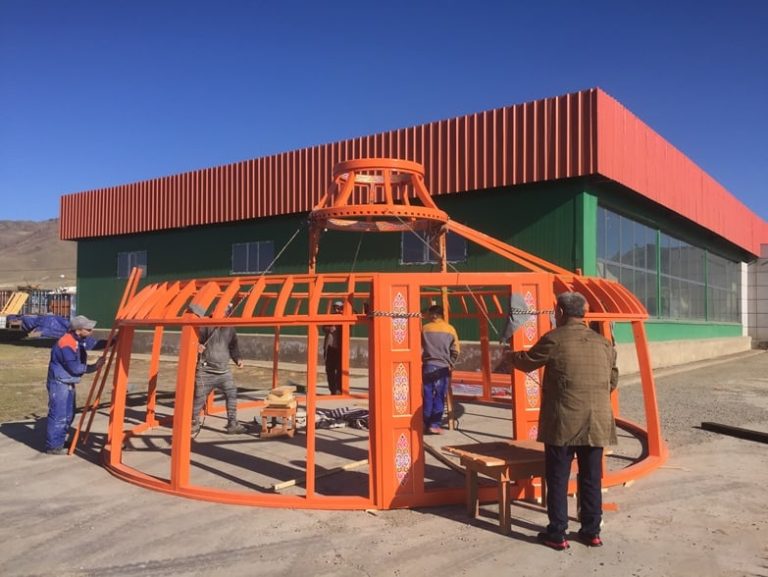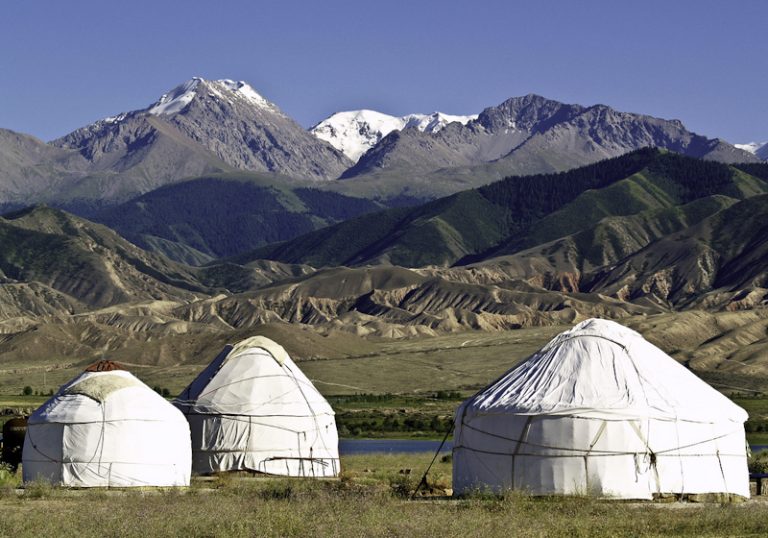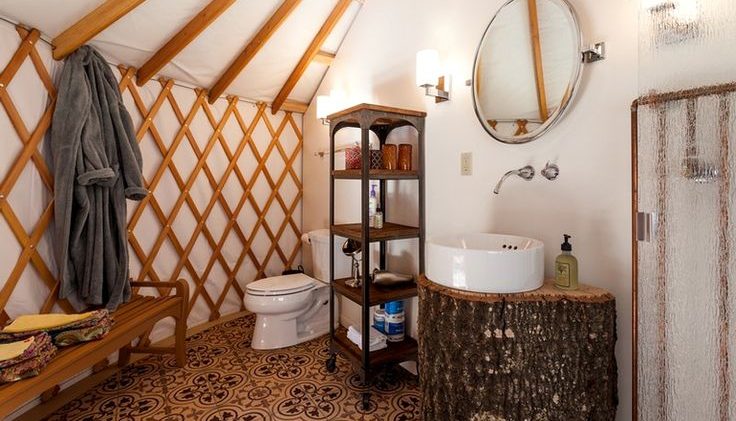What is a Yurt? Everything You Need to Know
A yurt is a portable, round tent traditionally used by nomadic peoples in Central Asia, particularly in Mongolia, Kazakhstan, and Kyrgyzstan. Yurts are made of a wooden frame covered with felt or canvas, allowing them to be easily assembled, disassembled, and transported.
History & Origins of Yurts
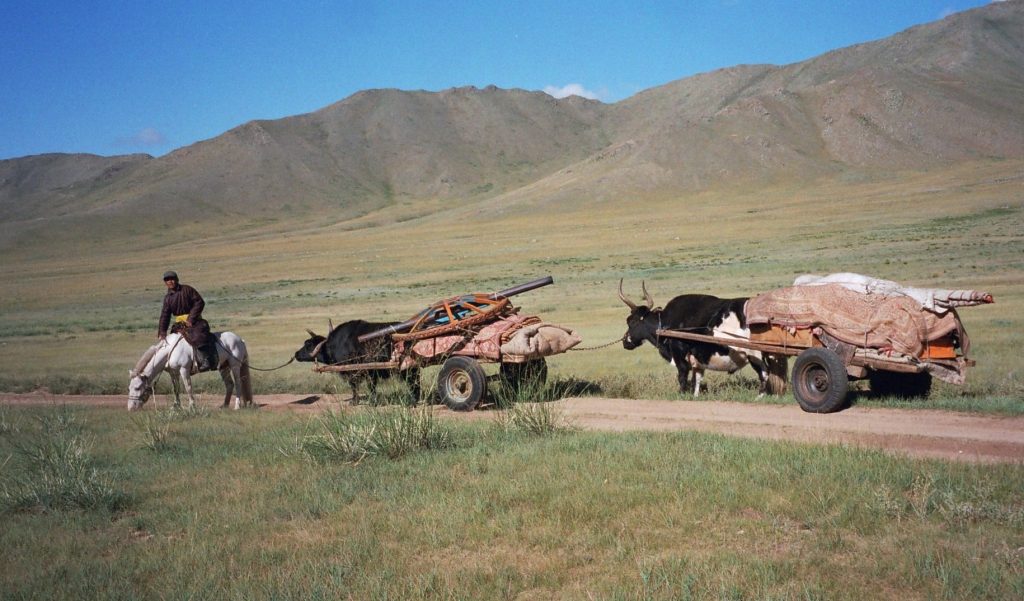
The yurt has a rich history that dates back thousands of years, with its origins deeply rooted in the nomadic cultures of Central Asia. It is believed to have first appeared around 3,000 years ago and has since been an essential part of life for nomadic peoples, particularly the Mongols, Kazakhs, Turkmen, and Kyrgyz.
Early Origins
The exact origins of the yurt are difficult to trace, but evidence suggests that early forms of the structure were used by nomads on the vast steppes of Central Asia. These nomadic tribes relied on livestock herding, and the portability of the yurt made it the perfect dwelling for their lifestyle. Yurts were designed to withstand the harsh weather conditions of the steppe, including extreme cold, heat, and strong winds.
Evolution and Design
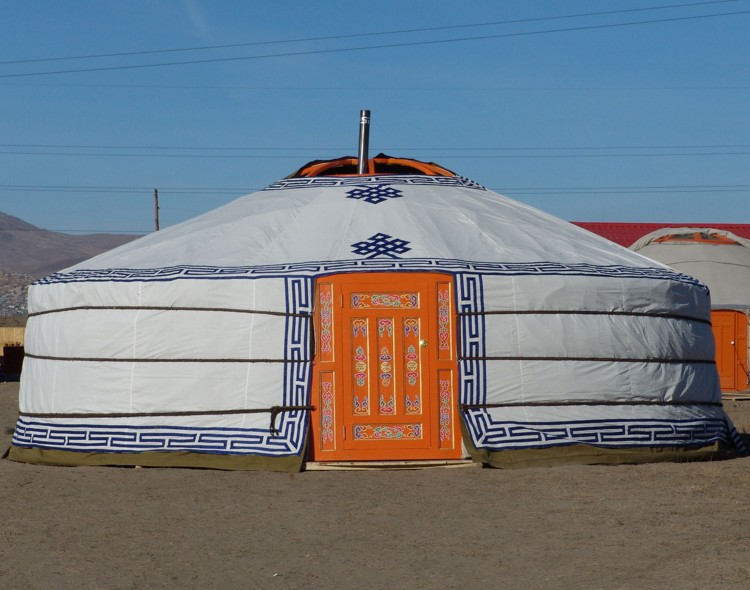
Over time, the yurt evolved to become a sophisticated, versatile shelter that could be quickly assembled and disassembled. The design of the yurt likely developed from basic, more primitive shelters like tents, but its circular form and wooden lattice structure provided superior stability and insulation. The wooden frame allowed it to be sturdy, while the felt or animal hide coverings helped keep the interior warm during the frigid winters and cool in the hot summers.
Mongolian yurts (known as “ger”) became iconic during the time of the Mongol Empire in the 13th century, when Genghis Khan and his armies traveled vast distances across the Eurasian continent. The mobility and efficiency of the yurt allowed the Mongols to carry their homes with them as they expanded their empire.
Read more: Origins of The Yurt
Structure of a Yurt
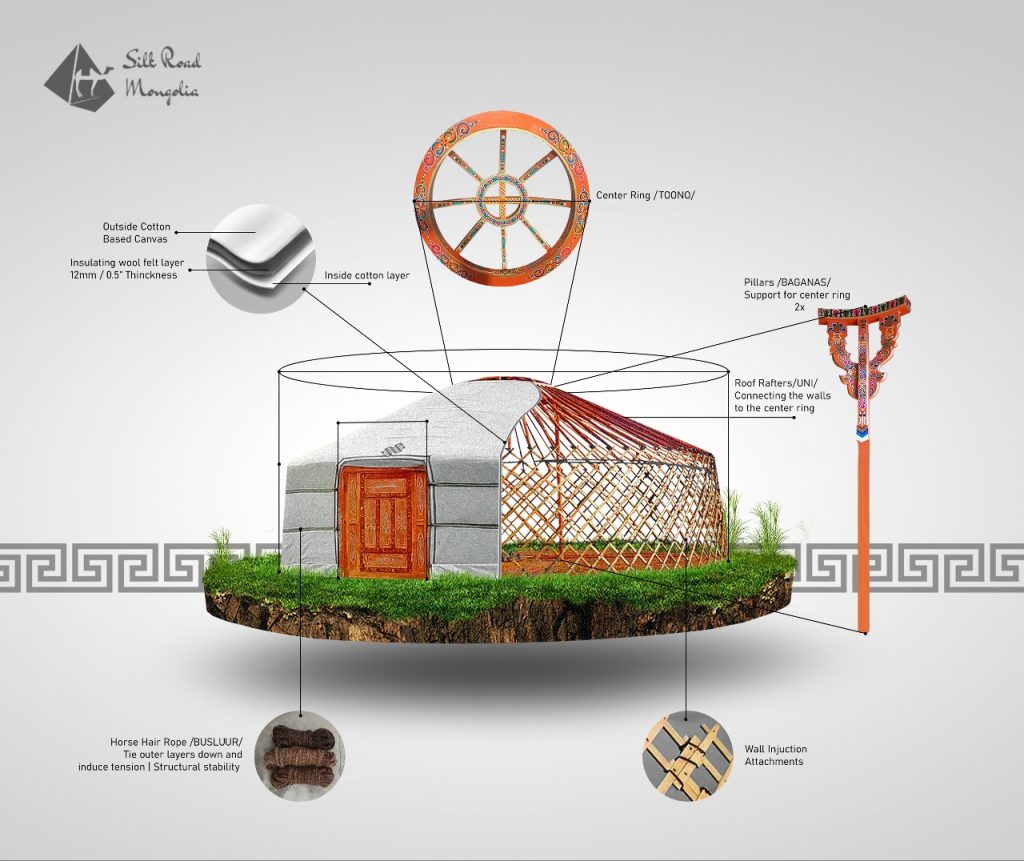
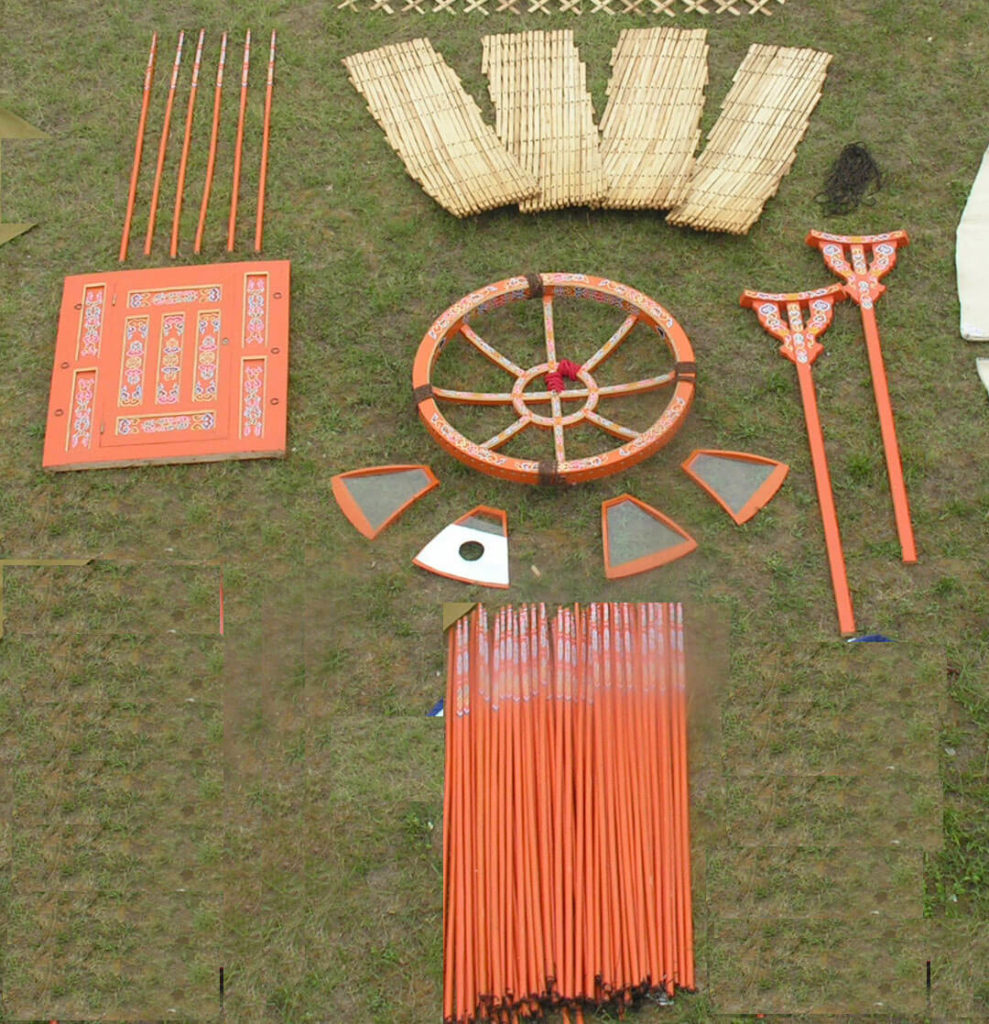
1. Crown (Toono)
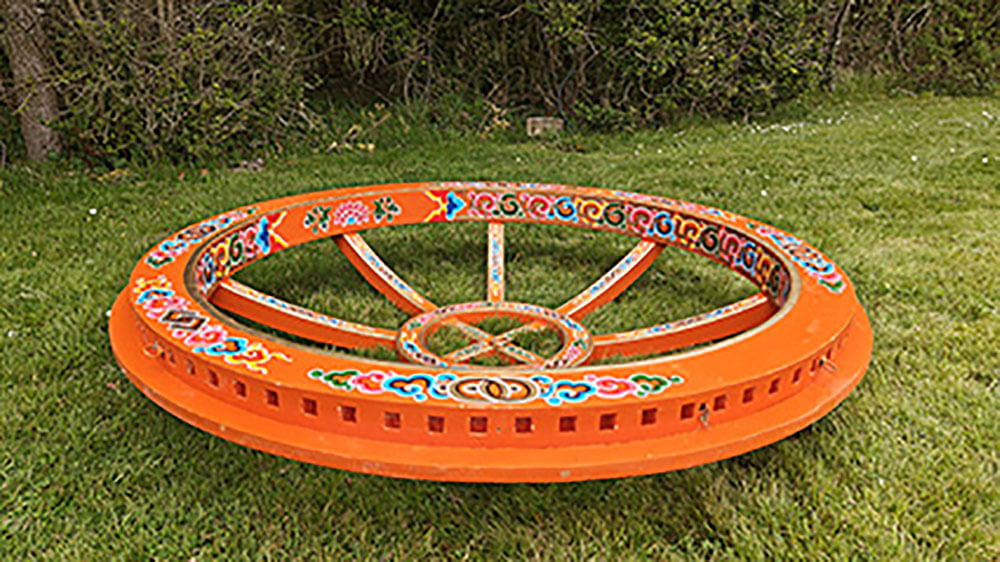
- The toono is the circular crown at the top of the yurt and serves as a central feature. It holds the roof poles (uni) in place and allows for ventilation and sunlight to enter the yurt.
- It usually has a smoke hole in the middle, which can be covered or left open, depending on the weather or the need for a chimney for the stove.
2. Roof Poles (Uni)
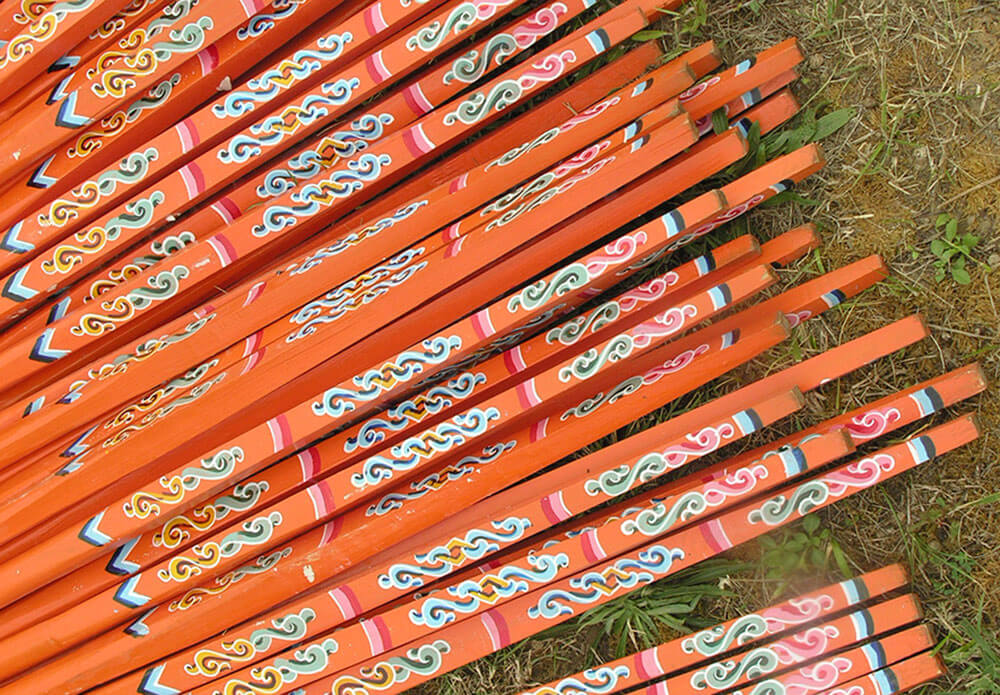
- These are the slanted poles that extend from the top of the walls to the toono.
- The number of uni can vary depending on the size of the yurt, but they are typically arranged in a radial pattern, supporting the roof while creating a dome-like structure.
- The uni are flexible and provide structural stability, dispersing the weight evenly across the yurt.
3. Walls (Khana)
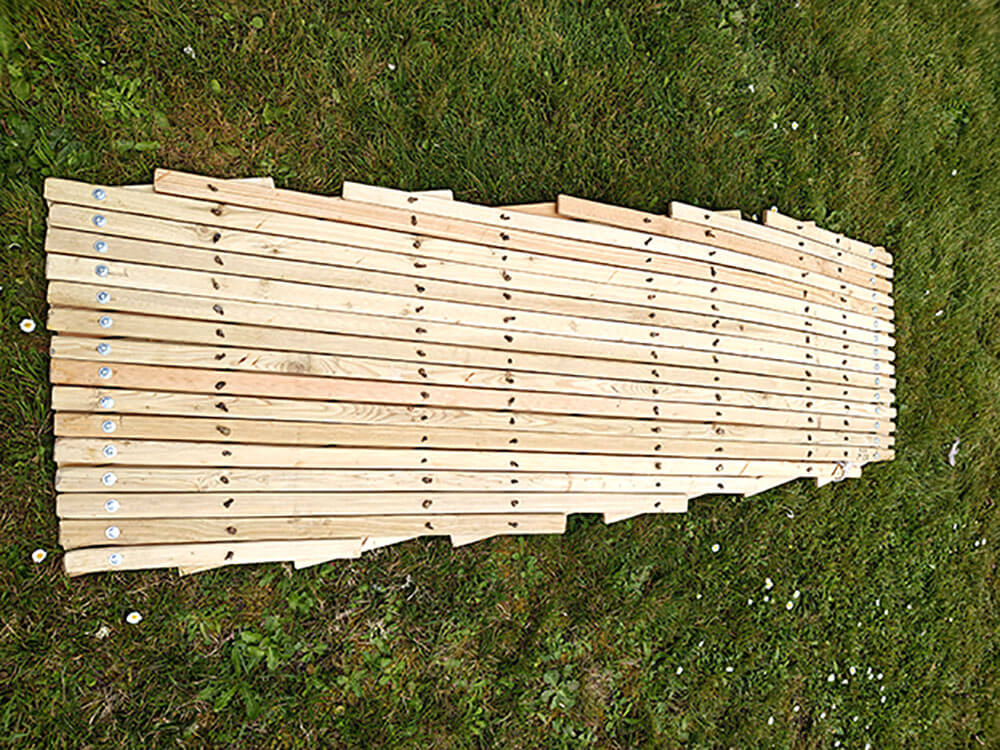
- The walls, known as khana, consist of wooden lattice frames (often made of birch or willow), which form the circular base of the yurt.
- These lattice walls can be collapsed or expanded, making the yurt portable and easily adjustable in size.
- The khana are interconnected and tied with leather or strong ropes, and they act as a flexible foundation for the yurt’s covering and insulation.
4. Door Frame and Door
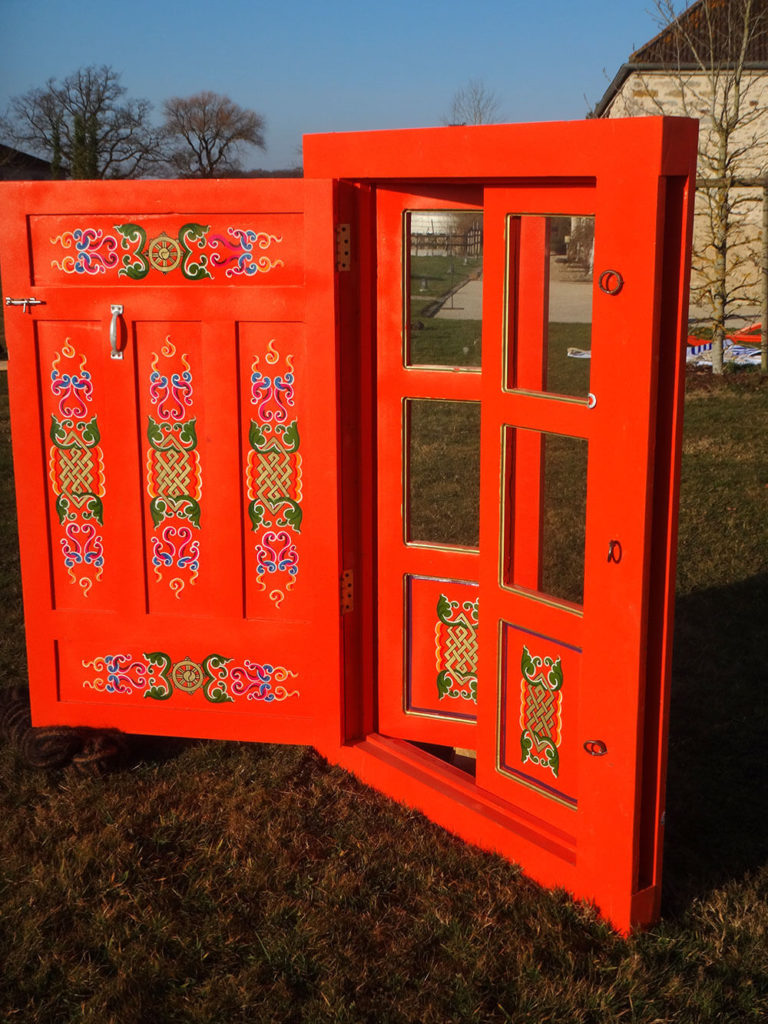
- The door frame is the only rigid, non-curved part of the yurt, typically facing south in Mongolian tradition.
- The door itself is usually wooden and can be intricately decorated with traditional Mongolian patterns.
- This solid door contrasts with the otherwise flexible structure of the yurt and is an essential part of its design.
5. Coverings (Felt and Canvas)
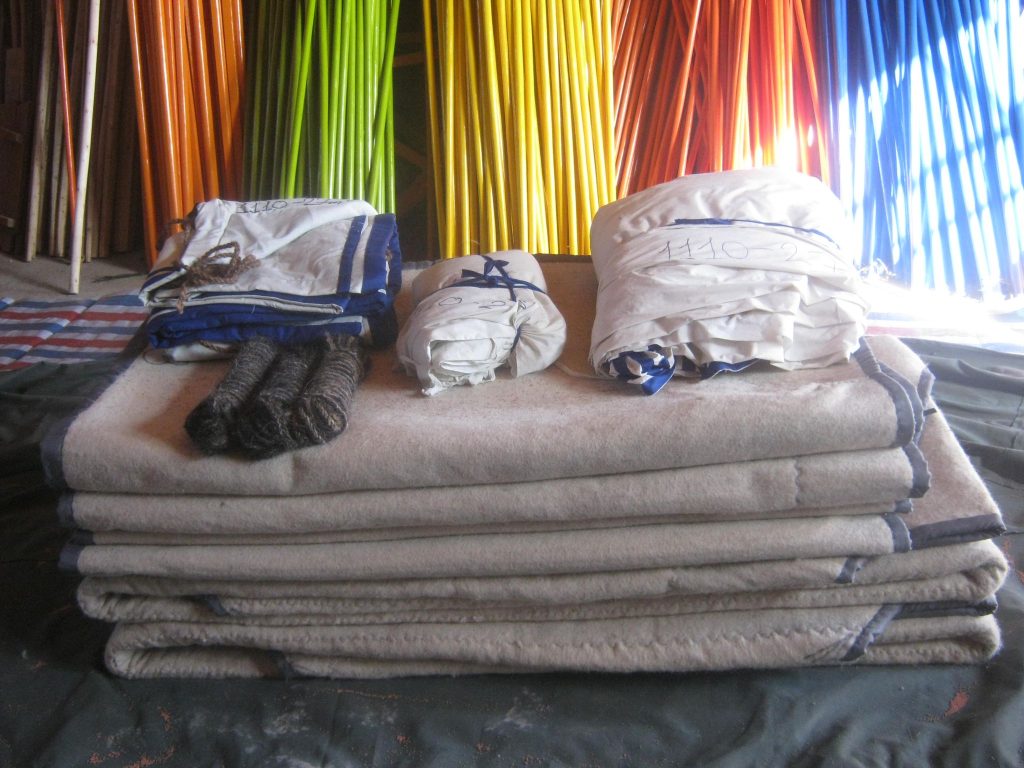
- A yurt is covered with several layers of material for insulation and weatherproofing:
- Felt: The primary insulating layer, traditionally made from sheep’s wool, is thick and provides protection from both cold and heat. Felt is breathable but insulating, allowing moisture to escape while keeping warmth inside.
- Canvas or outer covering: This waterproof layer (often made from cotton or synthetic materials today) protects the felt from rain and snow.
- Decorative cover: In some cases, a decorative cloth layer is added over the felt for aesthetic purposes, featuring traditional Mongolian designs and colors.
6. Tension Bands
- A belt or rope made of wool or horsehair is wrapped around the outside of the yurt, midway up the walls. This belt helps keep the yurt’s structure stable and ensures the wooden lattice doesn’t spread out under the weight of the roof and coverings.
- These bands are essential for maintaining the yurt’s shape, especially in high winds.
Read: What’s Inside The Yurt
Types of Yurts
There are several distinct types of yurts, each reflecting the cultural and environmental needs of the people who use them.
Mongolian Yurt (Ger)

The Mongolian yurt, commonly called a ger, is one of the most iconic and traditional types of yurts. It features a circular structure with a wooden lattice framework for the walls and roof poles that connect to a central crown (toono). The felt covering, made from sheep’s wool, provides excellent insulation, keeping the interior warm during Mongolia’s harsh winters and cool in the summer.
The door of a Mongolian ger typically faces south to maximize sunlight. These yurts are portable, easy to set up, and can be disassembled and moved as the nomadic lifestyle demands.
The Mongolian yurt’s design has remained largely unchanged for centuries.
Turkic Yurts
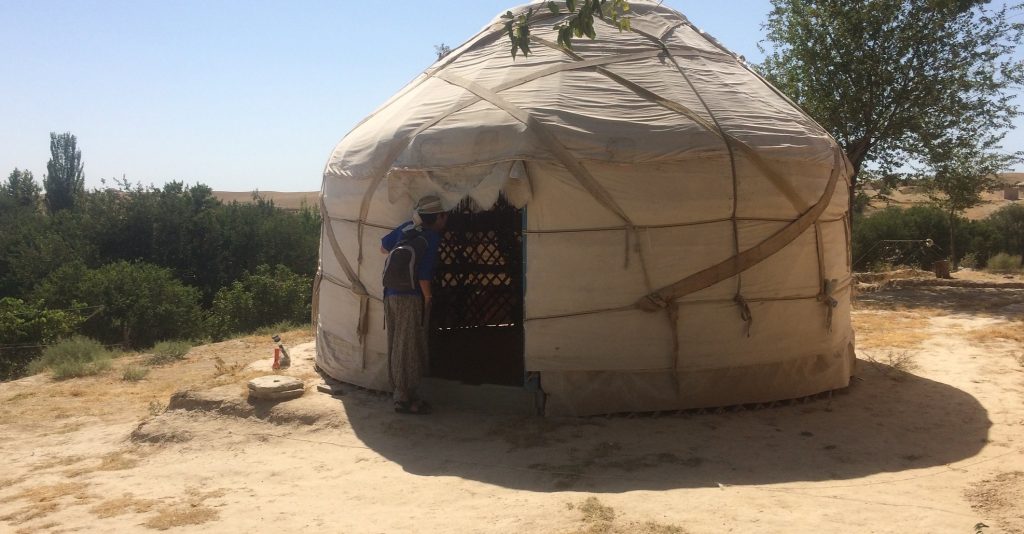
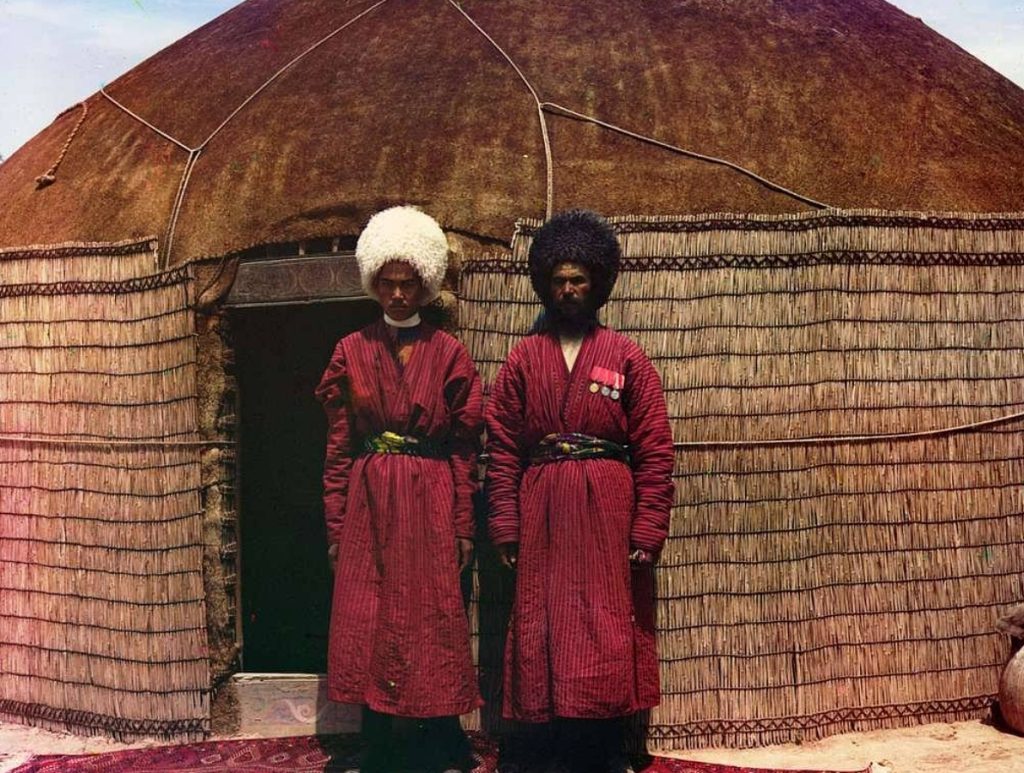
The Turkic yurt is found among various nomadic groups, such as the Kyrgyz, Kazakh, and Turkmen peoples of Central Asia. While it shares many similarities with the Mongolian ger, such as the wooden lattice walls and circular shape, there are some notable differences. The Turkic yurt tends to have a more ornate design, with colorful and decorative elements both inside and outside.
Modern Yurts
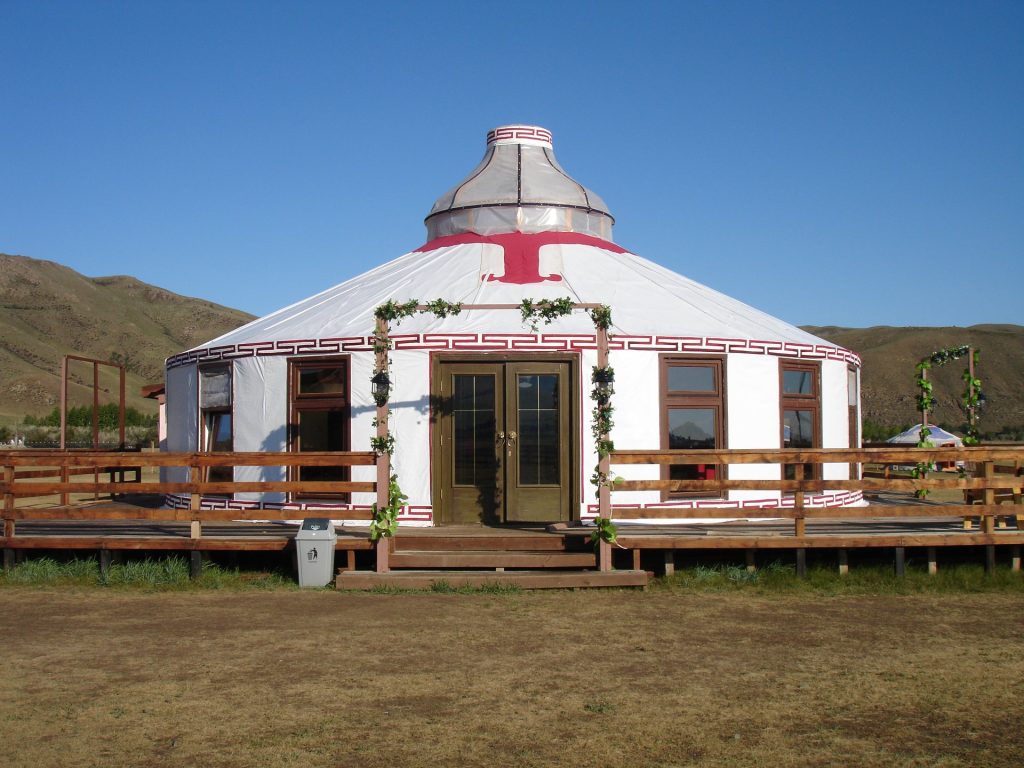
In recent years, modern yurts have gained popularity worldwide, particularly in eco-friendly housing and glamping (luxury camping).
These yurts are often inspired by traditional designs but incorporate modern materials like steel frames, insulated fabric, and synthetic coverings.
Modern yurts can be equipped with electrical systems, plumbing, and even solar panels, making them suitable for long-term living or vacation homes.
They retain the round shape and overall aesthetic of traditional yurts but are more durable and weather-resistant. Many modern yurts are used as off-grid homes or cabins in remote areas due to their sustainability and low environmental impact.
Glamping/Camping Yurts

Glamping yurts are a modern adaptation of the traditional yurt, designed to combine the charm and simplicity of nomadic living with the comfort and luxury of high-end accommodation. The term glamping (a blend of “glamorous” and “camping”) reflects the idea of camping without sacrificing amenities, and glamping yurts perfectly embody this concept.
Advantages of a Yurt
Yurts offer a variety of advantages, making them an efficient and versatile housing solution. Here are the key benefits:
1. Portability
- Easy to assemble and disassemble: Yurts can be set up or taken down in a few hours, making them ideal for nomadic lifestyles. This portability allows people to move their homes as needed, particularly for those who need to follow herds or migrate based on seasonal changes.
2. Durability in Extreme Weather
- Adaptable to harsh climates: Yurts are specifically designed to withstand a wide range of weather conditions. The circular shape makes them resistant to strong winds, while the thick layers of felt insulation keep them warm in winter and cool in summer.
- The dome roof effectively sheds rain and snow, preventing accumulation.
3. Energy Efficiency
- Yurts are naturally energy-efficient due to the insulating properties of felt (traditionally made from sheep’s wool) and their compact, round design. This allows for even heat distribution, which reduces the amount of energy required to keep the space warm or cool.
- The central stove or heater easily heats the entire structure with minimal fuel.
4. Eco-friendly
- Traditionally built using natural materials like wood and felt, yurts have a minimal environmental impact.
- Modern yurts can be made using sustainable materials and eco-friendly construction practices, making them a popular choice for environmentally conscious living.
5. Affordability
- Compared to conventional homes, yurts are much more affordable to build and maintain. The cost of materials and labor is significantly lower, and ongoing expenses, like heating or cooling, are minimized due to the yurt’s insulation efficiency.
6. Flexibility of Use
Yurts are highly versatile and can be used for various purposes beyond traditional housing, such as:
- Temporary or permanent homes.
- Guest houses or vacation cabins.
- Glamping accommodations.
- Yoga or meditation spaces.
- Event venues, offices, or workshops.
7. Minimal Maintenance
- Yurts are relatively low-maintenance structures. Their simple design means fewer components that can break down, and repairs are usually easy to manage.
- The materials used (like felt, canvas, or synthetic coverings) are generally durable and can last many years.
8. Connection with Nature
- Yurts offer a closer connection to the natural environment due to their design. The central crown (toono), often left open, allows natural light to enter, while the circular structure fosters a sense of openness and harmony with the surroundings.
- Living in a yurt encourages a simpler, more minimalist lifestyle in tune with nature.
9. Quick Setup
- A yurt can be constructed quickly—often within a day or two with a small team. This is ideal for those needing temporary shelters, fast accommodations, or minimal construction time for off-grid or rural areas.
10. Aesthetic Appeal
- Yurts, particularly the Mongolian ger, have a unique and pleasing aesthetic. Their rounded form and interior space create a calming, spacious feel that is different from traditional square or rectangular buildings.
How a Yurt is Set Up
Keep in mind that yurt construction requires a team, and more hands for faster build.
Preparation:
Platform Setup:
- Build a wooden platform, preferably raised off the ground.
- Use plywood or other suitable materials. A local carpenter or handyman can assist, or follow provided instructions.
Stage 1: Fitting the Door & Trellis:
- Attach the trellis to the door and each other.
- Start by stretching out the trellis just above the door height.
- Diagonally cut pieces of wood help fit the trellis into the door smoothly.
- Proceed to link additional trellis sections, ensuring proper alignment.
Stage 2: Wall Connection & Tying:
- Use a simple rope tying method.
- Begin with an overhand knot at the top and continue snaking down.
- Maintain two points of contact between the trellis sections.
- Tie off the tension rope, ensuring a tight fit around the yurt.
Stage 3: Attaching Support Posts to the Crown:
- Tie support posts to the crown using overhand or fisherman’s knots.
- Place support posts strategically, avoiding painted or carved areas.
- Ensure equal distances from the door to the back and sides.
Stage 4: Inserting Roof Poles:
- Insert roof poles into the crown following the numbered order.
- Secure poles with horsehair ropes and ensure an equal distribution around the yurt.
- Adjust tension bands to prevent the crown from lifting.
Stage 5: Applying Felt and Waterproof Canvas Cover:
- Apply wool felt sections starting from one side of the door.
- Overlap felt sections and secure them using rocks or weights.
- Place a drip edge to prevent water accumulation.
- Cover the yurt with a waterproof canvas, ensuring proper overlap and sealing.
Stage 6: Securing Lapels & Straps:
- Attach lapels to secure the waterproof cover to the yurt.
- Use straps with overhand knots and a trucker’s hitch for secure fastening.
- Tie down the yurt at multiple points to ensure stability.
Final Steps: Tensioning, Checking:
- Use tension straps to keep the yurt secure.
- Adjust as needed and ensure even pressure.
- Check for any shifts and make necessary adjustments.
Frequently Asked Questions
Here are some frequently asked questions about yurts.
Are yurts suitable for all climates?
Yurts are highly adaptable and can be used in a variety of climates. The felt used in traditional yurts provides excellent insulation, keeping the interior warm in cold weather and cool in hot weather. The circular design and roof structure help to manage wind and snow loads. However, additional modifications or insulation may be needed for extreme conditions, such as very heavy snowfall or intense heat.
How long does it take to set up a yurt?
The time required to set up a yurt depends on its size and complexity, as well as the experience of the builders. A traditional yurt can generally be assembled in a few hours to a day. The process involves erecting the wooden frame, attaching the roof poles, and covering the structure with felt and canvas. With practice, the assembly process becomes more efficient.
Can yurts be used year-round?
Yes, yurts can be used year-round, although their effectiveness in extreme climates might require some additional adaptations. In colder regions, yurts are often equipped with stoves or heaters to maintain warmth. In hotter climates, ventilation and shading can help keep the interior cool. Modern adaptations of yurts often include enhanced insulation and climate control features for year-round use.
How do you maintain a yurt?
Maintaining a yurt involves regular inspections and care of both the structure and the covering materials. This includes:
- Checking for wear and tear on the wooden frame and felt covering.
- Cleaning the felt and canvas to remove dirt and debris.
- Repairing any damage promptly to prevent deterioration.
- Ensuring proper ventilation to prevent mold and moisture buildup.
Are yurts eco-friendly?
Yes, yurts are considered eco-friendly. They are built from natural materials like wood and felt, which have minimal environmental impact. Their design also promotes energy efficiency through effective insulation and minimal use of non-renewable resources. Many modern yurts are designed with additional eco-friendly features, such as solar panels and water-saving systems.
How do you heat a yurt?
Traditional yurts are heated using a central stove or fireplace, often powered by wood or coal. The circular design of the yurt allows for even heat distribution throughout the space. In modern yurts, heating systems may include propane heaters, electric heaters, or other types of climate control to ensure comfort.

